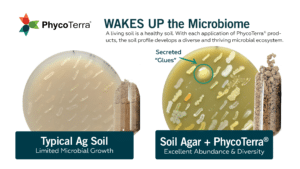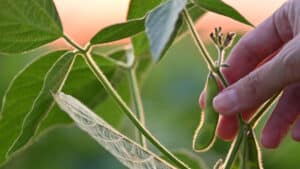#1: Soilborne Diseases Only Occur if Three Components are Present
The disease triangle happens when there is a susceptible host (your crops), a conducive environment (your soil), and a virulent pathogen. Growers don’t have to address all three components to avoid disaster. While integrated pest management (IPM) is the best strategy for managing diseases, if one component is controlled properly disease does not occur.

#2: Topple the Disease Triangle by Removing the Conducive Environment
Virulent pathogens will always try to find a way to attack crops. While you can buy disease resistant crop varieties, these can offer varying ranges of disease control.
Ensuring the environment isn’t conducive to pathogens is a great way to avoid soilborne diseases.
#3: There are Two Kinds of Microbes in Your Soil and It’s Important to Know the Difference
Beneficial microbes improve your soil and crop health. Pathogenic microbes can ruin your harvest. When the beneficial microbes in your soil are supported, they protect your crops from soil borne diseases and create DSS. Also known as, an unconducive environment.
#4: 75% of your Beneficial Microbes are Dormant or Inactive
Dormant and inactive soil microbes can’t create DSS. To support your beneficial microbes, consider:
- Rotating your crops to improve microbial diversity
- Implementing a no-till or low-till practice to support a healthy microbiome
- Feeding your soil microbes a carbon rich microbial food to wake them up
- Adding organic inputs as an additional food source
#5: Once Awake, Beneficial Microbes Create Inhospitable Environments for Diseases
Beneficial microbes and crops have a symbiotic relationship. The microbes need the nutrients and exudates created by your crops. In return, the soil microbes secrete exudates to cause disease-resistant responses from plants.
When active beneficial microbes outnumber pathogenic microbes, they increase competition and block pathogenic microbes from accessing vital nutrients. Some beneficial microbes will also secrete antibiotic-like enzymes and release exudates to protect your crops. Hyperparasitism and antibiosis can infect and kill pathogenic microbes.
By feeding your microbes, you can create DSS and topple the disease triangle.
#6: Activated Soil Microbes Provide A Long List of Other Benefits Beyond DSS
Well-fed microbes also support increased crop yield potential, nutrient retention, water retention and infiltration, and help fertilizer applications go further. If a dog is a farmer’s best friend, then beneficial microbes are a farm’s best friend.
Make disease suppressive soil one of your goals for 2023. Your crops will thank you.









